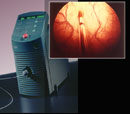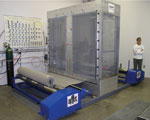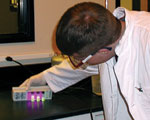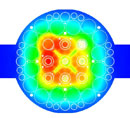
|
Laboratory Spinoff Successes
 Amtech®—founded in 1984 by five LANL researchers—makes dedicated short-range communications systems based on radio frequency identification technology. Products enable communication between readers and electronic tag devices attached to vehicles, equipment and containers. The TransCore Amtech Technology Center in Albuquerque, NM leads current R&D efforts for products used by companies worldwide to identify, track, and monitor railway, toll points, and parking, and for other access-control applications. Amtech®—founded in 1984 by five LANL researchers—makes dedicated short-range communications systems based on radio frequency identification technology. Products enable communication between readers and electronic tag devices attached to vehicles, equipment and containers. The TransCore Amtech Technology Center in Albuquerque, NM leads current R&D efforts for products used by companies worldwide to identify, track, and monitor railway, toll points, and parking, and for other access-control applications.
|
Í ndigo Medical Inc.—collaborated with LANL scientists in the late 1980s to develop a new, nonsurgical way to treat benign prostate enlargement. "We modeled it computationally, built the first prototype instruments, and carried them through animal trials," said the former LANL scientist who received one of the original patents. Following Food and Drug Administration approval, the Índigo-830 device has been on the market for several years. Johnson & Johnson acquired the company in 1996 for $140 million. ndigo Medical Inc.—collaborated with LANL scientists in the late 1980s to develop a new, nonsurgical way to treat benign prostate enlargement. "We modeled it computationally, built the first prototype instruments, and carried them through animal trials," said the former LANL scientist who received one of the original patents. Following Food and Drug Administration approval, the Índigo-830 device has been on the market for several years. Johnson & Johnson acquired the company in 1996 for $140 million. |
 APJeT, Inc., a Laboratory spinoff located in Santa Fe, has licensed the Laboratory’s Atmospheric Pressure Plasma Jet (APPJ) technology portfolio. This technology can be used for multiple surface treatment applications including photoresist ashing, non-aqueous cleaning, adhesion promotion, etching, and film deposition and is being applied to textiles, paper, plastics, and natural or synthetic fibers. In 2005, APJeT received an STTR Phase I award from the Air Force. APJeT has a large entity investment partner and currently employs 10 people. APJeT, Inc., a Laboratory spinoff located in Santa Fe, has licensed the Laboratory’s Atmospheric Pressure Plasma Jet (APPJ) technology portfolio. This technology can be used for multiple surface treatment applications including photoresist ashing, non-aqueous cleaning, adhesion promotion, etching, and film deposition and is being applied to textiles, paper, plastics, and natural or synthetic fibers. In 2005, APJeT received an STTR Phase I award from the Air Force. APJeT has a large entity investment partner and currently employs 10 people.
|
 MTI MicroFuel Cells Inc. is a subsidiary of Mechanical Technology Inc., which develops and manufactures advanced, cord-free, rechargeable, power pack technology for portable electronics. MTI Micro was founded as a spinoff around the license of Los Alamos' portfolio of Direct Methanol Fuel Cell (DMFC) technology. MTI Micro has developed and patented miniaturized, proprietary DMFC technology called MobinTM. MobinTM generates electrical power using 100% methanol as fuel. The cord-free power packs are intended to replace current lithium ion and similar rechargeable battery systems in the future. MTI MicroFuel Cells Inc. has 60 employees and is located in Albany, New York. MTI MicroFuel Cells Inc. is a subsidiary of Mechanical Technology Inc., which develops and manufactures advanced, cord-free, rechargeable, power pack technology for portable electronics. MTI Micro was founded as a spinoff around the license of Los Alamos' portfolio of Direct Methanol Fuel Cell (DMFC) technology. MTI Micro has developed and patented miniaturized, proprietary DMFC technology called MobinTM. MobinTM generates electrical power using 100% methanol as fuel. The cord-free power packs are intended to replace current lithium ion and similar rechargeable battery systems in the future. MTI MicroFuel Cells Inc. has 60 employees and is located in Albany, New York.
|
 Doxcelerate (formerly IWA, Inc.)—founded in 1996 by three LANL employees on Entrepreneurial Leave—provides a workflow system that allows geographically dispersed users to collaborate on producing corporate policies, reports, and procedures. The company's original search and retrieval technology, first deployed in 1994, was part of the Department of Energy’s Technology Information Network, a collaborative effort between LANL and 10 other DOE laboratories. Doxcelerate, a leading solution provider for multi-author documentation, employs nine people in Los Alamos, NM. Doxcelerate (formerly IWA, Inc.)—founded in 1996 by three LANL employees on Entrepreneurial Leave—provides a workflow system that allows geographically dispersed users to collaborate on producing corporate policies, reports, and procedures. The company's original search and retrieval technology, first deployed in 1994, was part of the Department of Energy’s Technology Information Network, a collaborative effort between LANL and 10 other DOE laboratories. Doxcelerate, a leading solution provider for multi-author documentation, employs nine people in Los Alamos, NM.
|
 QTL Biosystems was founded by two Lab researchers on Entrepreneurial Leave of Absence. QTL stands for Quencher-Tether-Ligand, a new technology invented by the co-founders. Products are based on a proprietary QTL molecular component that enables a single-step, instantaneous, homogeneous assay. The QTL concept enables a remarkably versatile new line of biosensing and biomedical assay products. The company received over $10 million in financing from DARPA and private investors. QTL employs 22 people in Santa Fe, NM. QTL Biosystems was founded by two Lab researchers on Entrepreneurial Leave of Absence. QTL stands for Quencher-Tether-Ligand, a new technology invented by the co-founders. Products are based on a proprietary QTL molecular component that enables a single-step, instantaneous, homogeneous assay. The QTL concept enables a remarkably versatile new line of biosensing and biomedical assay products. The company received over $10 million in financing from DARPA and private investors. QTL employs 22 people in Santa Fe, NM.
|
 Elemetric Instruments, formerly Advanced Realtime Technologies, is a Lab spinoff that licensed an air particulate monitoring technology to detect toxic elements such as beryllium. In total, Elemetric was awarded $150,000 in commercialization grants from the Center for Commercialization of Advanced Technology, a public-private collaborative partnership between academia, industry, and government. This funding will allow Elemetric to complete its first portable, analytical, continuous real-time monitor and demonstrate the technology to interested government agencies and customers in private industry. The company is driven by the desire to address environmental, industrial hygiene, and occupational safety issues. Elemetric Instruments, formerly Advanced Realtime Technologies, is a Lab spinoff that licensed an air particulate monitoring technology to detect toxic elements such as beryllium. In total, Elemetric was awarded $150,000 in commercialization grants from the Center for Commercialization of Advanced Technology, a public-private collaborative partnership between academia, industry, and government. This funding will allow Elemetric to complete its first portable, analytical, continuous real-time monitor and demonstrate the technology to interested government agencies and customers in private industry. The company is driven by the desire to address environmental, industrial hygiene, and occupational safety issues.
|
 Transpire
Inc., licenses the Attila radiation
transport solver code from the Laboratory. The code's
developers and company co-founders, former Laboratory employees,
have helped Transpire improve the ease-of-use and performance
of this software
to
provide a complete
radiation
transport software
system that can improve product safety, performance, and reliability.
This package can be used in cancer therapy, medical imaging,
and homeland
security applications. Transpire has received two Phase
I SBIR (Small Business Innovative Research) grants, one Phase
II SBIR grant, and one Phase
I STTR (Small Business Technology Transfer) grant. Transpire
currently employs a staff of seven. Transpire
Inc., licenses the Attila radiation
transport solver code from the Laboratory. The code's
developers and company co-founders, former Laboratory employees,
have helped Transpire improve the ease-of-use and performance
of this software
to
provide a complete
radiation
transport software
system that can improve product safety, performance, and reliability.
This package can be used in cancer therapy, medical imaging,
and homeland
security applications. Transpire has received two Phase
I SBIR (Small Business Innovative Research) grants, one Phase
II SBIR grant, and one Phase
I STTR (Small Business Technology Transfer) grant. Transpire
currently employs a staff of seven.
|
 HYTEC—established in 1993 by two former LANL design engineers—uses LANL-licensed imaging and measurement technology to perform high-speed, industrial, 3-D X-ray scanning. The company's well-equipped prototyping and testing laboratories in Los Alamos, NM provide full-service engineering and development to customers. HYTEC currently employs about 40 people. HYTEC—established in 1993 by two former LANL design engineers—uses LANL-licensed imaging and measurement technology to perform high-speed, industrial, 3-D X-ray scanning. The company's well-equipped prototyping and testing laboratories in Los Alamos, NM provide full-service engineering and development to customers. HYTEC currently employs about 40 people.
|
|
 |
